Senior art
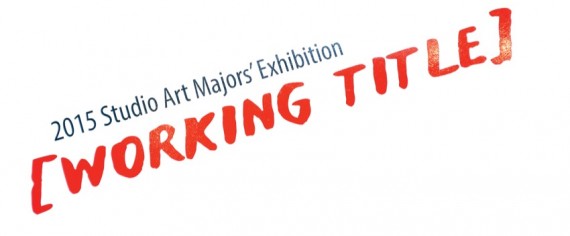
The name of the show, which students came up with, is “their way of conveying a sense of work in progress, that their education will always continue and their work will change,” noted advisor Kelly Goff, assistant professor of art and art history.
Read artist statements below:
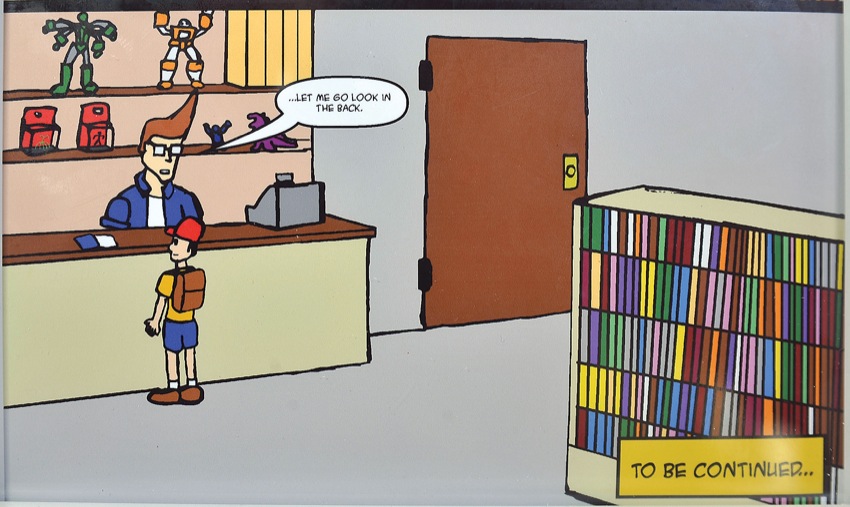
Medium: Print, sketch, digital editing
Brandt Berrie
Ever since I was a kid, I always found myself drawing and making comics during classes or in my free time. My friends and I would also trade our own comics back and forth, and would get together to create stories that spanned several issues and characters from all of our stories. During my Senior Seminar I wanted to look back at this and approach it with a more serious intent. The pages I’ve produced are mainly a product of many of the comics I read growing up.
My process for making the pages was similar to those used by Marvel, DC, and other big name companies. I first wrote the script of the comic itself, which was then followed by a crude storyboard. After the storyboards were fleshed out, versions of the pages featuring more detail in both the characters and backgrounds were created. Starting out in pencil, these pages were then retraced with permanent ink markers on transparent acetate sheets. The acetate sheets were then scanned onto a computer, where coloring, shading, and final touchups were added in.
The pages I have up are intended to be a prologue to the main story, introducing the two focal points of the comic (the fictional hero and “real” comic book owner). In later stories the comic would touch upon many ideas and tropes seen through comic books, including the origin story, the proper use of one’s power, and the responsibilities that come with them.
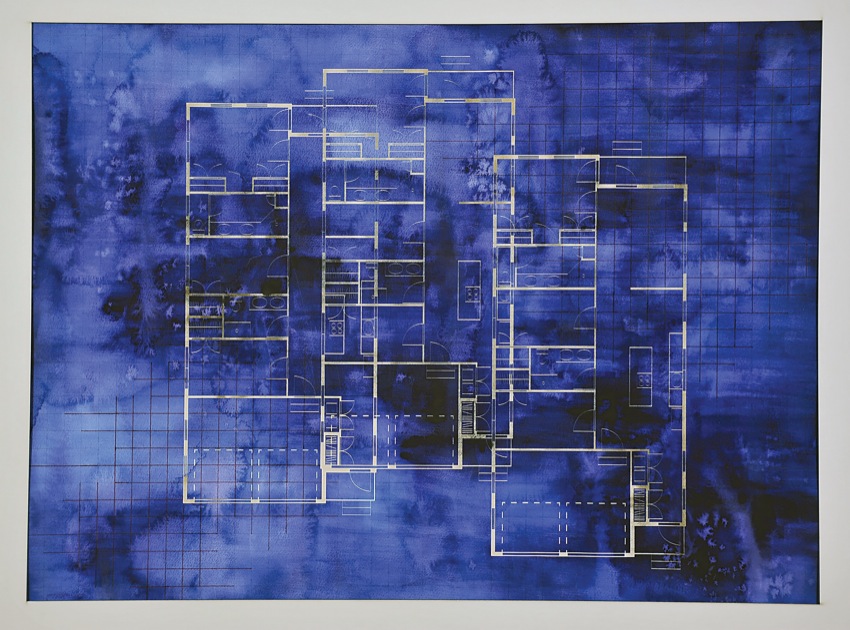
Medium: Watercolor, paper, pencil, pen, salt, laser cutting
Mikéla Boudette
Houses in planned communities often occupy narrow lots, to maximize profit, and include only a handful of architectural plans and design choices. By removing the client from the design process, these communities champion their cohesion through repetition and predetermined and nominal options that give the inhabitants a false sense of customization. Due to the lack of a natural evolution and the suppression of the individual, the planned development disregards the strength of a community that promotes unique ideas and diversity. When the architecture is molded to the user, and not vice versa, is when the architecture gains richness and is both aesthetically and socially successful.
The juxtaposition between the organic and the linear within this work exemplifies the dichotomy between the individual and the planned community. The overlapping architectural plans, illustrated with clear and rigid lines, depict the limited number of designs offered and their recurrence throughout the development. The watercolor, as a fluid and expressive medium, signifies the individual residents and the uniqueness of various household structures, despite inhabiting a community of banal replications.
The mediums used were specifically chosen to elevate the artwork and to reference traditional architectural methods. The watercolors, painted in various hues of blue, reflect conventional blueprints and acknowledge the use of watercolors in pre-digital architectural renderings. The laser cutter, a tool for model building, is used atypically to etch the plans into the painting. The implementation and combination of these architectural devices allows for a more evident and substantial contrast between the organic and the rectilinear, as well as the individual and the planned community.
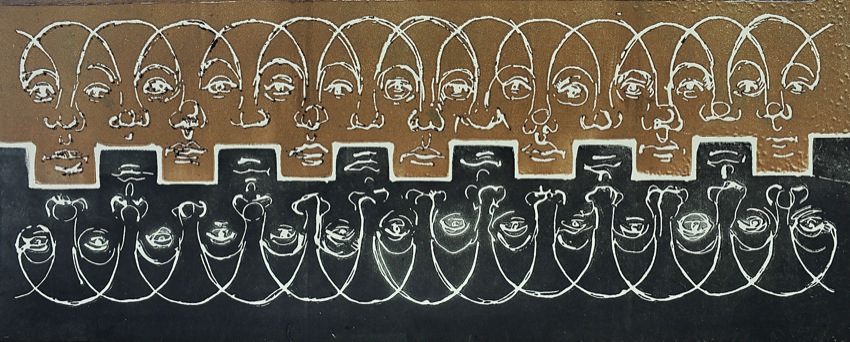
Medium: Intaglio print
Alexandra Foster
In my work I explore the idea of interconnectivity among people as well as between human community and the natural and built environment. This work references the way we influence and are influenced by our social and physical worlds. By drawing people morphing into others, I consider how our identities are not only are own, but rather are entwined and created by our every interaction with others. These images evolved from a process of constant sketching of what I see and think, and the desire to turn these visual notes into more sophisticated images. I work in Intaglio printmaking because I enjoy the push and pull of the medium and its close relation with drawing. By combining images from my imagination and from life I have created invented imagery, which remains based in the fundamental principles of observational drawing.
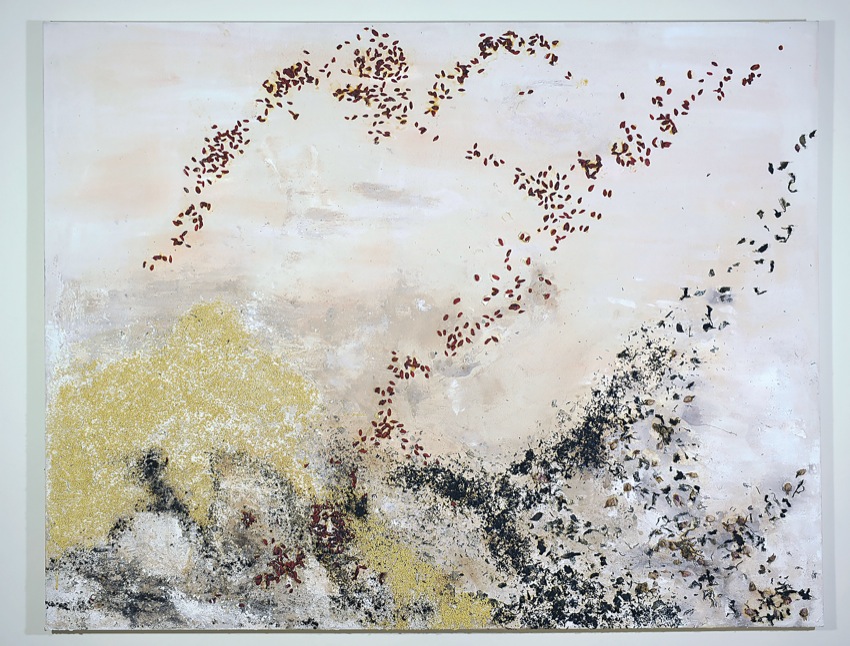
Medium: Mixed media on canvas
Tianxiao Fu
The organic particles from the nature form the prospect of the landscape. Every kind of material I choose is close to life. The trollflower tea and lonicera japonica tea balance yin and yang of the body. The millet and red bean function of nursing the stomach. Those red drops at the top are wolfberries, and they warm the body as well as preserve the eyesight. The background is the mixture of sand, green tea leaves, rose tea, coffee powder, lavender and red wine. The collection of coffee and tea is from all over the world. The red wine produces a fine color on the canvas. The green tea with sweet-scented osmanthus has been applied to harmonize colors. The interfusion of scents refreshes the contemplation.
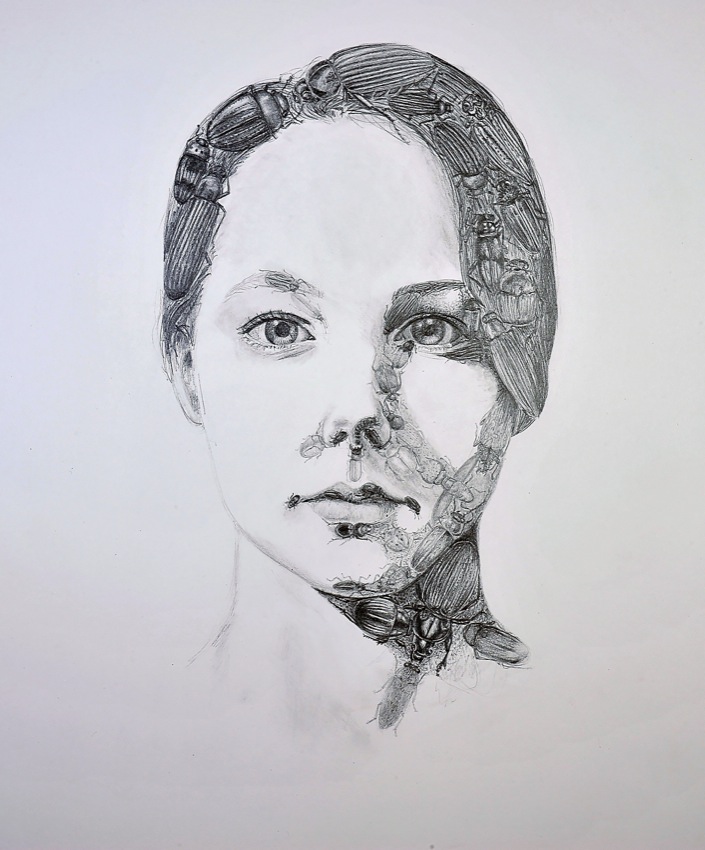
Medium: Graphite on Bristol board
Lindsey Gillis
Human fears are natural. They evolved with us as a way to survive and avoid situations and creatures that could potentially harm us. Modern shelters and technology protect us from many of the dangers that once threatened our distant ancestors, yet these fears remain.
Fears and phobias become part of our identities and influence our decisions on conscious and subconscious levels. “Fight or flight” responses are well known reactions, but there is a third biologically-rooted response to fear—the act of “playing dead.”
Each subject in my work is frozen in their tracks, staring their fear in the face. Each subject is also defined by their fear, created by the object they fear. The works are intended to evoke a sense of uneasiness, but even still, a desire to look closer and investigate something I am inspired by through my work in biology. The work is informed by old black-and-white biological illustrations as well as the accumulations of objects seen in Guiseppe Archimboldo’s portraits. I used pencil to keep the materials simple, allowing the focus to remain on the subject and the specimens, while paying homage to traditional biological illustration and specimen display.
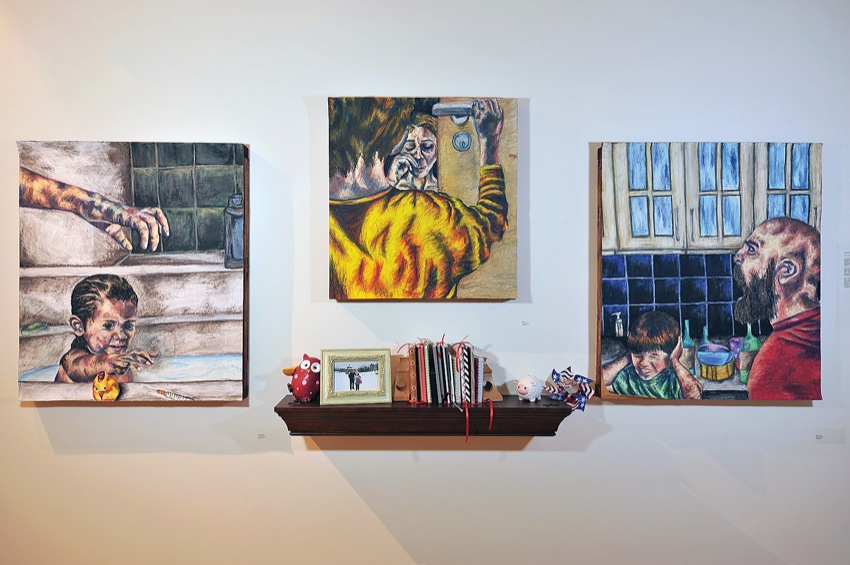
Medium: Oil
Nichole Haar
As humans we gain so many different experiences during our lives, and I am a firm believer that personal experiences help create who we are as individuals. Since I have such an interest on the formation of individuals, as an artist my work is inspired by people who have experienced struggle, helplessness and irregularity life styles. This personal interest in people being created out of struggle and irregular life styles has led me to the current exhibition of my series entitled Dirty Laundry.
Every day humans interact with other humans; sometimes our interactions are focused on people that we know well and other times they are concentrated on unknown individuals. Either way, I’ve noticed that people always have skeletons in their closet. We as individuals like to hide our stories about struggle, feelings of helplessness, and irregular life styles because we fear that we will be judged by society. We fear that people will judge our past experiences, our families, and our friends because of what they have done.
As an individual, I have been exposed to substance-related tragedies in household settings, which I have always kept a secret. However over the years I have noticed that I am not the only person who keeps these skeletons in their closet. Thus, for my series Dirty Laundry, I decided to reach out to individuals by asking them to share their anonymous family secrets about one of the most commonly judged concepts; drug abuse. After spending time collecting a series of family secrets, I decided to take some of the impactful written narratives and re-create them as large scale and high color intensity illustrations.
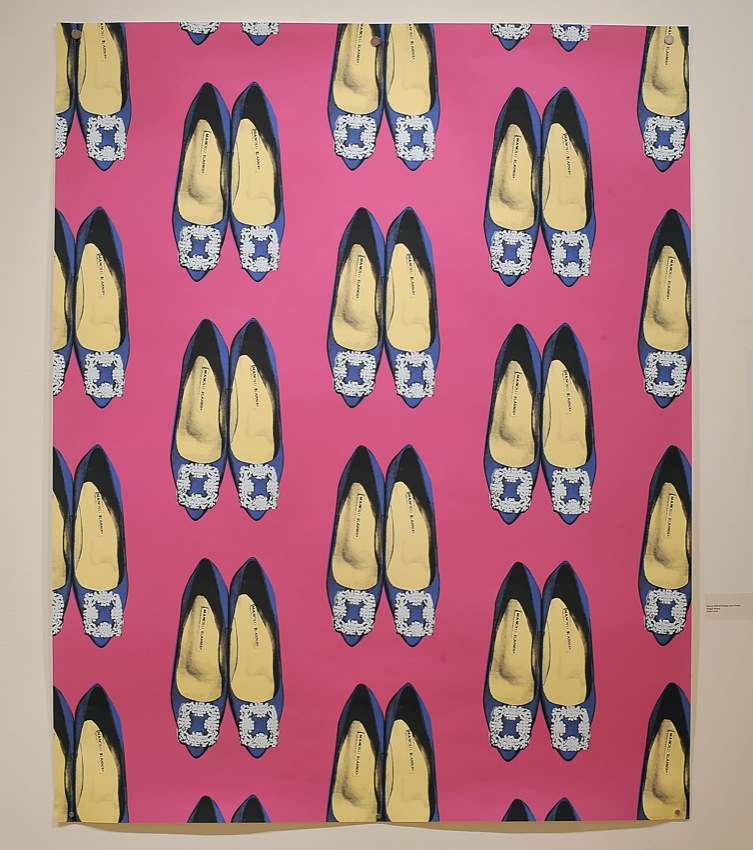
Medium: Digital print
Abigail Matses
In the mid-century, the Pop Art movement sought to blur the boundaries between “high art” and “low art,” making art more accessible to the public majority by depicting familiar and relatable objects. My prints are stylistically inspired by works such as Warhol’s Campbell’s Soup Cans (1962), but reverse Pop Art’s intent by depicting objects that are both largely inaccessible and unfamiliar.
Each print features an icon of high fashion culture in order to initiate discourse about consumer culture, commercialism and accessibility. This project calls into question the normalization of elite fashion culture, and highlights the disparity between commoditized luxury objects and the easily accessible medium on which they are represented. This ultimately sparks questions of class, privilege, community and authority. The social intent here is multifaceted: it offers a “commentary on the politics of appearance” while simultaneously celebrating and critiquing the “spectacle of marginality.”
The visual repetition in the prints refers to reproducibility and replaceability within an exclusivist material culture. The clothing items are prêt-à-porter, or ready-to-wear, and thus reproducible by the manufacturer or designer. When these luxury goods are juxtaposed with human fashion icons, the resulting work not only questions fashion’s oligarchical structure of commercial power and influence, but also turns the individual into a commodity.
The concept of reproducibility is reinforced through digital means, as it allows for the possibility of infinite prints. This theoretical multiplicity enables the art to act as advertisement, perpetuating current social tropes surrounding luxury fashion, while also critiquing it through mimicry and repetition. As a whole, these prints reflect on a contemporary consumer culture, colored by rich historical framework of fashion as commodity, fashion as social representation, and fashion as art.
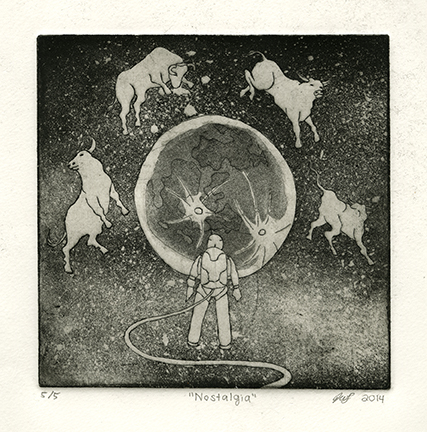
Julie Schirrmeister
I draw inspiration from the world around me, especially the natural and built environment. I often choose to manipulate the reality of my subject slightly in order to create a surreal atmosphere. I enjoy using my artistic freedom to put my own spin on events in order to explore new relationships between humans and the world in which we live.
I find the many intricate and complex relationships between humans and the world compelling and seek to convey this through printmaking. By doing so, I address one of the most fundamental issues I see today—how the world shapes us and how we shape the world. This relationship is becoming more relevant in the face of rising and controversial environmental concerns. The prevalence of technology in peoples’ day-to-day lives is such that they often lose touch with their surroundings. By placing human forms in the environment I am re-establishing an important connection I feel is lost to many in today’s materialistic society.
My artistic progression over the past few years has led me to the art of intaglio printmaking. The joy I experience by thoroughly immersing myself in the many materials and steps involved in creating a print is uplifting. I use techniques, such as etching and aquatint, to create fluid lines combined with varying value tones. It is through the process of printmaking that I am able to leave my mark, both on the plate and on the world.
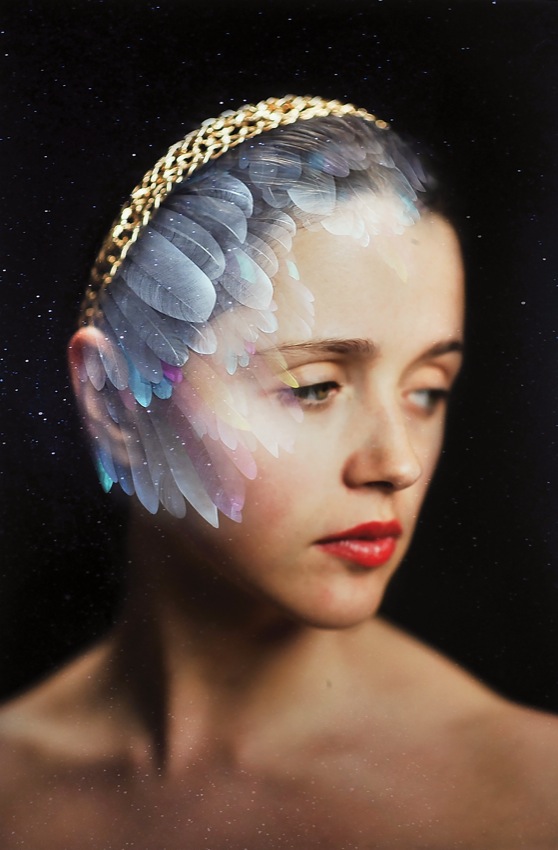
Medium: Photography
Changyue Wang
I have been corrupted by Hollywood.
When I was snuggling on my bed this very morning, I realized that I have been corrupted by Hollywood.
Every evening before I go to bed, I examine my identity, making sure that it is intact. I tell myself, “I have been corrupted by Hollywood.”
The more frequently I say this to myself, the stronger I feel that this is true and I am actually allowing myself to be corrupted.
I feel that I am being judged by skeptical glances.
When an “awkward” moment like this happens. I say, “Oh, please.” I find somewhere quiet and assume the persona and posture of a mannequin. I light up my cigarillos, and say, I have been corrupted by thee, Hollywood!
It can be hard to havefaith these days. I have found a lot of empty souls out there, and all they are doing is just […] looking instead of searching. The fabricated capital of the film capitol that generates hundreds of thousands of fantasies on a daily basis.
Faith is impulsive.
One of my favorite quotes from a poet who’s name I cannot remember exactly, says, “You have to have the courage to examine who you really are, to come to terms with the dark corner of your own soul.”
I felt bad. And I feel bad.
I should have never insulted or even dared to tarnish glorious Hollywood with these false accusations.
Sincerely,
Sophia
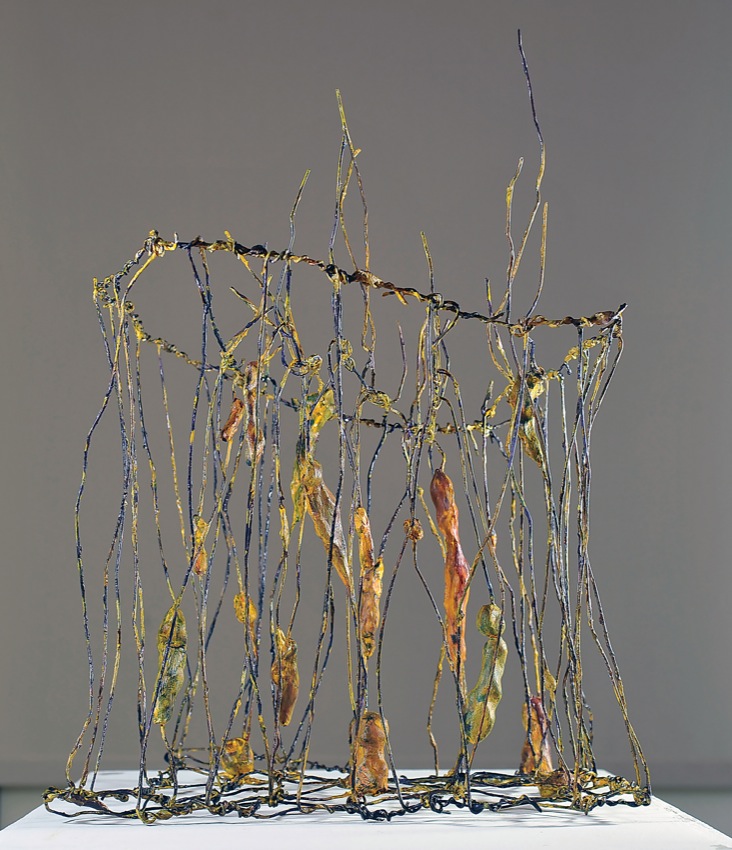
Medium: Acrylic paint on wire and clay
Shiya Wu
I am always in a silent personal dialogue with my artwork. The feeling I put into my artwork speaks back to me. We are afraid that the literal meaning interrupts the visual, destroying all the possible interactions between the artwork and the viewers. In this world, there are always layers within layers of meaning, and I want my artwork to reflect such illusionary qualities.
Life is a large experiment. Making art is about doing experiments about myself. Through the experiment, I am getting to know another side of myself and what I am probably thinking. I believe that being human is like always wandering between two opposite poles, such as childishness and maturity, innocence and evil, restraint and freedom, intention and unconsciousness, and controlled and uncontrolled. It is hard to know where we are exactly, who we are specifically, since we are wandering all the time.
This artwork explores both physical and psychological cages. It involves the intersection of different layers of interpretation and confusion. We think we have freedom, but we might be in a cage. We think others lock us in the cage, but we might be the people who imprison ourselves. There might be no such thing as freedom or restriction. The boundary between innocence and evil is also very obscure. Everyone has an evil or naughty child living in his or her mind. Evil children are sometimes like angels, sometimes like devils. Even rational adults make immature decisions.
Yifan Zhang
Hunger breeds discontentment. The lack of palatable cuisines always suffocates me at the most unexpected moments. Waves of feelings sweep over me every time when I yearn for the tasteful dishes. The desire for food inspires me to paint this series Intangibility, by which I hope to resonate with the viewers. Yet, my depiction of food is not meant to be perfect nor pleasurable.
In my paintings, I destroy some of my favorite foods in various ways aiming to express my frustration and discomfort. Through the theatricality in my paintings, I intend to provoke the viewers to explore and experience the deepest void in their mind. The intangibility that I strive to convey can only be defined by being exposed to the depressiveness—what you want is not what you can have.
